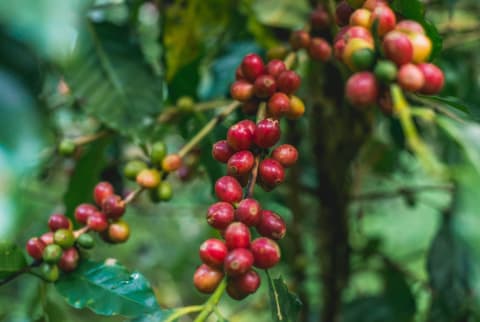Advertisement
What Exactly Is A Coffee Cherry? Potential Health Benefits Of This Underrated Fruit


The ever-ubiquitous roasted coffee bean might be the first thing that comes to mind when you think about café. But what about its small berries?
Coffee beans are actually the seeds of the plant, housed inside a green or red fruit (depending on the ripeness), referred to as a coffee cherry, berry, or drupe. Usually discarded during the coffee-making process, these often-overlooked fleshy fruits have recently gained more popularity in the wellness and sustainability worlds—and for good reason.
Beyond playing an instrumental role in coffee's ultimate flavor development, the antioxidant-rich fruit is a caffeine powerhouse with promising health potential.
What is a coffee cherry?
You might recognize a coffee tree by the grape-like fruits that grow in clusters along its branches. These shiny, juicy berries take almost a year to mature after flowering and another five before reaching their peak. Interestingly, coffee trees, which can live up to 100 years, grow in a perpetual cycle—which means you can find coffee flowers, along with green and ripe berries, on a single plant.
As part of the Rubiaceae family, coffee berries' outer skin is called the exocarp. This layer protects its seeds as it grows by preventing bugs or other species from eating the fruit. Then comes the mesocarp (a thin film of flesh), the parenchyma (a slimy layer), and finally, the seeds covered in a parchment-resembling case called the endocarp.
The two seeds (or beans) lie juxtaposed, each clothed individually by another thin sheath called the spermoderm, or silver skin, a group of sclerenchyma cells that firmly adhere to the beans. Eventually, during the roasting process, these skins fall off and become the so-called chaff. A small percentage of coffee berries will grow just one seed, often referred to as a peaberry, which is thought to produce sweeter-tasting coffee.
"The berries are ready to be harvested when they are ripe and tomato-red," says Ella Davar, R.D., CDN, CHC. "Ripe red berries are collected and pulped, and the mucilage is removed by fermentation."
What are the benefits?
They're a superb source of antioxidants.
The coffee cherry pulp is touted for its significant polyphenol and antioxidant2 content, which may help mitigate chronic disease and neutralize free radicals.
Because of their valuable bioactive compounds, coffee berries are also considered a convenient functional ingredient3, particularly in the health food industry. Yet, further research is needed to assess the effects of coffee cherries on humans. Also, the fruits' processing method might affect its antioxidant content4.
It offers a way to use the whole plant.
Cascara ("husk" in Spanish) tea results from boiling the coffee fruit's discarded skins into a subtly floral, cinnamon-tasting tea. Because it's brewed from dried fruit, cascara is closer to an herbal, tisane-like tea than brewed coffee.
Besides decreasing waste from coffee production, cascara—with its high caffeine content5 and antioxidant power—makes for a wholesome tea with potential to support cognitive abilities and improve physical performance6.
It might support brain health.
Caffeine found in coffee cherry pulp might also promote brain function. In fact, in one study that looked at 71 adults with mild cognitive decline, the participants who took coffee cherry extract in the morning or twice per day showed improvements in reaction times and accuracy7 during cognitive challenge tasks—compared to the placebo group. Supplementary research is still necessary to better understand coffee fruit's potential benefits for brain health, its possible medical treatments, or applications.
Are there any downsides?
If consumed in moderation, coffee fruit byproducts are usually considered safe8. However, their inherent caffeine content is a factor to keep in mind if you are sensitive to caffeine.
How can you use the fruit in your diet?
From an easy, homemade cascara tea recipe to extracts and powders—coffee cherry products are generally available at most health markets or drugstores. You might also find them in beauty products, essential oils, or beverage blends—to name a few.
If you buy coffee berries fresh, keep in mind that since they're perishable, you should consume them within a few days.
Bottom line.
Coffee berries, cherries, fruit, or drupes—whatever the name, this luscious, plump fruit from one of our favorite plants is worth a spot on your radar. Thanks to their superb antioxidant and caffeine levels, this unique fruit is worth using more often—both for its environmental and health potential.
8 Sources
- https://www.sciencedirect.com/science/article/pii/B9780128035207000128
- https://pubs.acs.org/doi/10.1021/jf200122m
- https://www.sciencedirect.com/science/article/pii/B9780124047389000039
- https://pubmed.ncbi.nlm.nih.gov/21401105/
- https://pubmed.ncbi.nlm.nih.gov/27979301/
- https://pubmed.ncbi.nlm.nih.gov/27612937/
- https://pubmed.ncbi.nlm.nih.gov/31829793/
- https://pubmed.ncbi.nlm.nih.gov/20600539/
